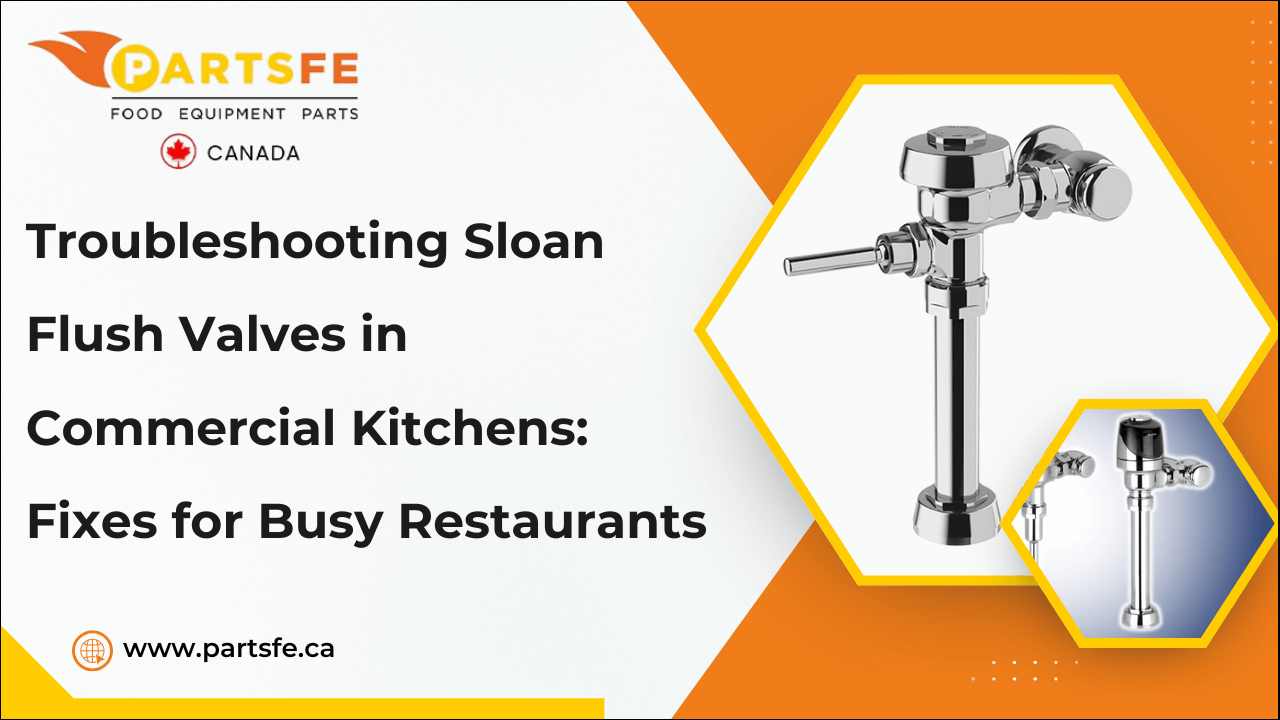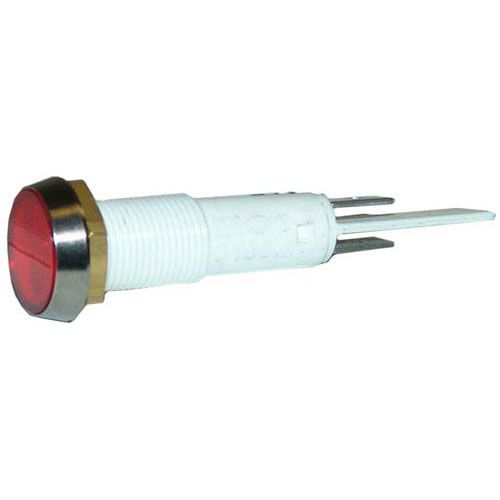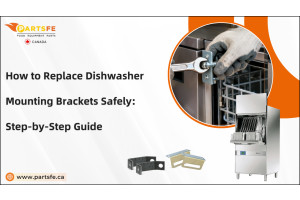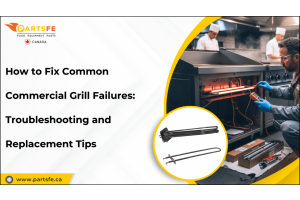Troubleshooting Sloan Flush Valves in Commercial Kitchens: Fixes for Busy Restaurants
In a busy commercial kitchen, efficient restroom facilities are just as important as a well-run kitchen. Sloan flush valves are widely used in restaurants for their durability and water-saving features, but even these reliable devices can face issues over time. Problems like constant running, weak flushes, or leaks not only waste water but can also disrupt daily operations and affect hygiene standards. For restaurant owners and maintenance staff, knowing how to identify and fix common flush valve problems quickly is crucial. Understanding and having the right Sloan valve parts on hand can make troubleshooting faster and more effective. This article dives into the typical challenges encountered with Sloan flush valves in commercial kitchens and provides straightforward troubleshooting tips to keep your restrooms functioning smoothly.
Understanding Sloan Flush Valves and Their Role in Commercial Kitchens
Sloan flush valves are a key component in commercial kitchen restrooms, designed to provide effective and efficient flushing for toilets and urinals. Their primary function is to deliver a strong, direct flow of water that quickly clears waste, which is especially important in busy commercial environments.
Key Features and Benefits:
-
Enhanced Hygiene: Quick and thorough flushing helps maintain sanitary conditions, reducing the risk of odors and bacterial buildup.
-
High Durability: Built from sturdy materials to withstand repeated use and exposure to cleaning agents, which are typical in culinary settings.
-
Water Efficiency: To cut down on water usage without sacrificing functionality, many models come equipped with sensor-activated or dual-flush technology.
-
Easy Maintenance: Designed to minimize downtime in high-traffic locations, with repairs made simple through the availability of reliable replacement Sloan flush valve parts.
-
User Convenience: Touchless options promote a contact-free experience, supporting health and safety standards.
-
Compliance: Meets or exceeds commercial plumbing codes, ensuring safe and reliable operation.
In commercial kitchens, Sloan flush valves deliver consistent performance and promote water efficiency. They are crucial for preserving hygiene and lowering maintenance due to their high-quality engineering and advanced features.
Need replacement parts for restroom issues in your busy restaurant? PartsFe CA has you covered with essential components like diaphragms, solenoids, and flush hooks from trusted brands such as Frymaster, Vulcan, Sloan, and Kason. Keep your restrooms clean and fully functional, ensuring your facilities run smoothly so your kitchen can focus on serving customers.
Common Problems with Sloan Flush Valves in Commercial Settings
Sloan flush valve parts are designed for heavy use, but can still face several common issues in commercial kitchens. Recognizing these problems quickly helps minimize downtime and maintain restroom efficiency. Typical problems include:
-
Continuous Running Water: It is often caused by a worn or damaged diaphragm or flapper that fails to seal properly, leading to water waste and higher utility bills.
-
Weak or Incomplete Flush: It can result from clogged valves, low water pressure, or faulty parts, causing waste buildup and unpleasant odors.
-
Leaking Valves: Leaks may occur around the handle, inlet, or valve body due to worn seals, loose connections, or corrosion, risking water damage and increased costs.
-
Noisy Operations: Hissing or banging sounds during flushing usually indicate water pressure issues or internal valve damage.
-
Sensor Malfunctions: In sensor-activated valves, dirt buildup, low battery levels, or wiring issues can cause the valve to fail to flush or flush erratically.
Identifying these issues early enables timely repairs, helping save water, reduce costs, and keep commercial restrooms operating smoothly.
Check out this detailed guide on restaurant sink drain plumbing problem fixes to quickly identify and resolve common issues that can disrupt your kitchen’s plumbing system.
Essential Tools and Safety Precautions for Troubleshooting Sloan Flush Valves
Before troubleshooting Sloan flush valves in commercial kitchens, it’s important to have the right tools and follow safety precautions to ensure effective repairs and prevent accidents.
Essential Tools
-
Adjustable Wrench: For loosening and tightening valve nuts and fittings.
-
Screwdrivers: Both flathead and phillips for removing covers and accessing internal parts.
-
Pliers: Handy for holding and working with small parts.
-
Replacement Parts: Such as diaphragms, gaskets, and seals, are commonly needed for repairs.
-
Cleaning Brush or Cloth: To clear any debris and dirt that could impair valve performance.
-
Flashlight: Helps illuminate tight or dark spaces inside the valve assembly.
-
Towels and Bucket: To catch water while making repairs and avoid spills.
Safety Precautions
-
Turn Off Water Supply: Always shut off the water supply to the valve before beginning any work to avoid flooding.
-
Wear Gloves: Keep your hands safe from cleaning agents, pollutants, and sharp objects.
-
Use Eye Protection: Safety goggles shield your eyes from water and debris.
-
Follow Manufacturer Guidelines: Refer to Sloan’s instructions to avoid damaging components.
-
Work in a Dry Area: Ensure the floor and workspace are dry to prevent slips and electrical hazards if working with sensor valves.
Using the right tools and observing these safety measures ensures smooth, safe, and efficient troubleshooting in busy commercial kitchen environments.
Sloan Flush Valve Troubleshooting Step-by-Step Process
Sloan flush valve troubleshooting is essential for maintaining reliable performance in commercial restrooms. This step-by-step guide outlines common issues and practical solutions to keep your flush valves operating smoothly.
Toilet Keeps Running Continuously
Issue: A worn or damaged diaphragm or a misaligned relief valve prevents the flush valve from sealing properly.
Cause: The flush valve fails to close properly, causing water to flow nonstop until manually stopped.
Fix:
-
Turn off the water supply at the shut-off valve.
-
Remove the flush valve cover or handle.
-
Inspect the diaphragm and relief valve for tears, cracks, or misalignment.
-
Clean any debris or mineral buildup from the valve components.
-
Replace the diaphragm and/or relief valve if damaged.
-
Reassemble the valve and turn the water supply back on.
-
Test flush to ensure the valve seals and stops running.
Weak or Incomplete Flush
Issue: The toilet does not clear waste fully, resulting in frequent re-flushing.
Cause: The cause of a weak flush is often debris buildup, partial blockages, or low water pressure from a partially closed valve.
Fix:
-
Turn off the water supply.
-
Remove the flush valve cover or handle.
-
Inspect and clean the diaphragm, bypass orifice, and other internal parts to remove debris or mineral buildup.
-
Check that the control stop valve is fully open to allow maximum water flow.
-
Replace worn or clogged components if cleaning doesn’t improve performance.
-
Reassemble the valve and turn the water back on.
-
Test the flush for proper strength and completeness.
Water Leaks from the Valve
Issue: Water escapes around the valve, causing leaks and potential water damage.
Cause: Leaks from the valve are caused by worn, damaged, or improperly seated seals and gaskets.
Fix:
-
Shut off the water supply.
-
Remove the flush valve cover or handle.
-
Inspect seals, gaskets, and ring seats for damage or warping.
-
Clean all components to remove buildup.
-
Replace any damaged seals or gaskets with compatible parts.
-
Reassemble carefully, ensuring seals sit correctly.
-
Turn the water on and check for leaks during testing.
Handle or Button is Hard to Operate or Stuck
Issue: The flush handle or button resists movement or sticks, making flushing difficult.
Cause: Grease, grime buildup, or mechanical wear causes the handle or button to stick or resist movement.
Fix:
-
Turn off the water supply.
-
Remove the handle or actuator button.
-
Clean the handle mechanism thoroughly using a mild detergent or descaling solution.
-
Lubricate moving parts if recommended by the manufacturer.
-
Replace the handle or button if worn or broken.
-
Reassemble the handle/button.
-
Turn the water on and test for smooth operation.
Check out this guide on pre-rinse faucets in a commercial kitchen to learn how the right fixtures can improve water efficiency, hygiene, and workflow in your foodservice operation.
Maintenance Tips to Prevent Future Flush Valve Problems
Regular maintenance is key to extending the life of your Sloan flush valves and avoiding unexpected issues. Follow these simple tips to keep your restroom systems running smoothly and efficiently.
-
Regular Inspections: Examine flush valves on a regular basis for wear, leaks, and strange noises. Costly repairs and downtime can be avoided with early problem diagnosis.
-
Clean Components: Dirt and mineral buildup can clog valves and sensors. To ensure peak performance, frequently wipe off sensor lenses and valve components using a gentle cloth and mild cleanser.
-
Check Water Pressure: Ensure water pressure stays within the manufacturer’s recommended range. Excessive pressure might harm valve components or produce flushing issues.
-
Replace Worn Parts Promptly: Diaphragms, gaskets, and seals wear out over time. To prevent leaks and flowing water, replace these parts as soon as deterioration is noticed.
-
Test Sensor Valves: For automatic flush valves, test sensors regularly and replace batteries when needed. Make sure the wiring is safe and undamaged.
-
Educate Staff: Train kitchen and cleaning staff to report any flushing issues immediately and avoid tampering with valve components unnecessarily.
Following these maintenance tips helps busy restaurants keep their Sloan flush valves running smoothly, conserving water, and maintaining a clean restroom environment.
Effective Sloan flush valve troubleshooting is essential for maintaining smooth restroom operations in busy commercial kitchens. By quickly identifying common issues like leaks, running water, or sensor malfunctions and knowing how to address them, restaurant staff can minimize downtime and water waste. These valves are further guaranteed to function dependably under demanding conditions by routine maintenance and the use of the appropriate Sloan automatic flush valve parts. Ultimately, staying proactive with Sloan flush valve care helps commercial restaurant kitchens maintain hygiene standards, control operating costs, and provide a better experience for both employees and customers.
FAQs
How do I reset a Sloan automatic flush valve?
To reset a Sloan automatic flush valve, hold your hand in front of the sensor for 10 seconds until the LED blinks, then remove it to trigger a manual reset. For battery-operated models, replacing the batteries may also perform a reset.
What causes a Sloan flush valve to keep running?
A constantly running Sloan valve is usually caused by a damaged diaphragm, a misaligned relief valve, or debris blocking the bypass orifice. These prevent the valve from sealing properly after a flush.
How does a Sloan flush valve work?
Sloan flush valves use water pressure and a diaphragm assembly to control the release of water during a flush cycle. In automatic models, a sensor detects user presence and activates the flush electronically.
How to adjust Sloan automatic flush valve?
You can adjust the flush volume by changing the diaphragm kit to one with a different flow rate or by modifying the control stop valve to regulate water pressure. Sensor range and duration can also be adjusted using the manufacturer's sensor settings or the remote control tool.








